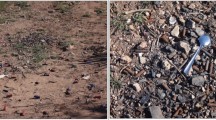Abstract
This study determined the spatial distribution of soiland of sediment-associated lead in Iqaluit, Nunavut.Samples were collected from the following areas:outside the built-up area of the town to reflectbackground concentrations; known or potential pointsources of lead, such as the Upper Base, the SylviaGrinnell Dump and the Metal Dump (North 40); andresidential and commercial areas of Iqaluit and Apex,a satellite community. In the laboratory, the <63 μm sample fraction was analyzed for total lead andbioavailable lead, estimated by non-residual acidextractable lead content. The research findings revealthat elevated levels of bioavailable lead are presentin the study area. Total lead concentrations generallydo not exceed environmental guidelines. However, leadconcentrations in the Sylvia Grinnell Dump, and Apexand Iqaluit grid areas exceed health-based guidelines.The research concludes that there is not a serioushealth hazard posed by lead levels in the soil andsediment in the study area. However, severalenvironmental (elevated lead levels, bioavailableforms of lead and bare soil surfaces) and behaviouralfactors (vigorous and unsupervised play outside) maycreate a risk of lead exposure.
Similar content being viewed by others
References
Andrews, J. T.: 1989, ‘Quaternary geology of the Northeastern Canadian Shield’, in R. J. Fulton (ed.), Quaternary Geology of Canada and Greenland, GSC No. 1, 276-317.
Blackadar, R. G.: 1967, Geological Reconnaissance, Southern Baffin Island, District of Franklin, GSC No. 66-47.
Baffin Regional Health Board (BRHB): 1994, Iqaluit Community Profile. Unpublished document, Iqaluit, Nunavut.
Brinkmann, R.: 1994, ‘Lead pollution in soils adjacent to homes in Tampa, Florida’, Environmental Geochemistry and Health 16, 59-64.
Chaney, R. L., Mielke, H. W. and Sterrett, S. B.: 1989, ‘Speciation, Mobility and Bioavailability of Soil Lead’, in B. E. Davies and B. G. Wixson (eds.), Lead in Soil: Issues and Guidelines, Environmental Geochemistry and Health, Science Reviews, Northwood: 105-129.
Connor, E. E., Scanlon, P. F. and Kirkpatrick, R. L.: 1994, ‘Bioavailability of lead from contaminated sediment in Northern Bobwhites, Colinus virginianus’, Archives of Environmental Contamination and Toxicology 27, 60-63.
Davis, A., Ruby, M. C., Goad, P., Eberle, S. and Chryssoulis, S.: 1997, ‘Mass balance on surface-bound mineralogic, and total lead concentrations as related to industrial aggregate bioaccessibility’, Environmental Science and Technology 31, 37-44.
Davis, A., Drexler, J. W., Ruby, M. V. and Nicholson, A.: 1993, ‘Micromineralogy of mine wastes in relation to lead bioavailability, Butte, Montana’, Environmental Science and Technology 27, 1415-1425.
Edlund, S.A: 1991, ‘Climate Change and its Effects on Canadian Arctic Plant Communities’, in M. Woo and D. J. Gregor (eds.), Arctic Environment: Past, Present and Future, Department of Geography, McMaster University, 121-135.
Elhelu, M. A., Caldwell, D. T. and Hirpassa, W. D.: 1995, ‘Lead in inner-city soils and its possible contribution to children' blood lead’, Archives of Environmental Health 50, 165-169.
Environment Canada: 1979, Analytical Methods Manual, Inland Waters Directorate, Water Quality Branch, Ottawa, Ontario.
Environmental Sciences Group (ESG): 1995, Environmental Study of a Military Installation and Six Waste Disposal Sites at Iqaluit, N.W.T. Volume One: Site Analysis, Department of Indian Affairs and Northern Development, Ottawa, Ontario.
Fairey, F. and Gray, J. W.: 1970, 'soil lead and pediatric lead poisoning in Charleston, S.C.’, The Journal of the South Carolina Medical Association, 79-82.
Hertzman, C., Ward, H., Ames, N., Kelly, S. and Yates, C.: 1991, ‘Childhood lead exposure in Trail revisited’, Canadian Journal of Public Health 82, 385-391.
Hilts, S. R.: 1996, ‘A co-operative approach to risk management in an active lead/zinc smelter community’, Environmental Geochemistry and Health 18, 17-24.
Horowitz, A. J.: 1985, A Primer on Trace Metal-Sediment Chemistry, U.S.G.C. Water-Supply aper 2277.
Jensen, J., Adare, K. and Shearer, R.: 1997, Canadian Arctic Contaminants Assessment Report, Indian and Northern Affairs Canada, Northern Contaminants Program, Ottawa, Ontario.
Luoma, S. N. and Bryan, G.W.: 1981, ‘A statistical assessment of the form of trace metals in oxidized estuarine sediments employing chemical extractants’, The Science of the Total Environment 17, 165-196.
Madhavan, S., Rosenman, K. D. and Shehata, T.: 1989, ‘Lead in soil: recommended maximum permissible levels’, Environmental Research 49, 136-142.
Mudroch, A. and MacKnight, S. D.: 1991, Handbook of Techniques for Aquatic Sediments Sampling, CRC, Ann Arbor.
Mudroch, A., Sarazin, L. and Lomas, T.: 1988, ‘Summary of surface and background concentrations of selected elements in the Great Lakes sediment’, Journal of Great Lakes Research 14, 241-251.
Nriagu, J. O.: 1978, The Biogeochemistry of Lead in the Environment. Part 1: Ecological Cycles, Elseview/North-Holland Biomedical Press, New York.
Ontario Ministry of Environment and Energy (OMEE): 1994, Scientific Critieria for Multimedia Environmental Standard Development-Lead.
Ontario Ministry of Environment and Energy (OMEE): 1993, Rationale for the Development of Soil, Drinking Water and Air Quality Criteria for Lead.
Sheppard, S. C., Evenden, W. G. and Schwartz, W. J.: 1995, ‘Ingested soil: bioavailability of sorbed lead, cadmium, cesium, iodine, and mercury’, Journal of Environmental Quality 24, 408-505.
Stone, M. and Marsalek, J.: 1996, ‘Trace metal composition and speciation in street sediment: Sault Ste. Marie, Canada’, Water, Air, and Soil Pollut. 87, 149-169.
Turjoman, A. M. and Fuller, W. H.: 1986, ‘Behavior of lead as a migrating pollutant in Saudi Arabian soils’, Arid Soil Research and Rehabilitation 1, 31-45.
Wixson, B. G. and Davies, B. E.: 1993, Lead in Soil: Recommended Guidelines, Science Reviews, Northwood.
Author information
Authors and Affiliations
Rights and permissions
About this article
Cite this article
Peramaki, L.A., Decker, J.F. Lead in Soil and Sediment in Iqaluit, Nunavut, Canada, and Links with Human Health. Environ Monit Assess 63, 329–339 (2000). https://doi.org/10.1023/A:1006253529308
Issue Date:
DOI: https://doi.org/10.1023/A:1006253529308




